|
Limitar tu búsqueda
[+–] Creator
- Aguayo Tellez, Ernesto (1)
- Aguilera, Nelly (1)
- Almeida de Menezes, Tatiane (1)
- Ayala Gaitán, Edgardo A. (1)
- Borraz, Fernando (1)
- Campolina, Bernardo (1)
- Campos Vázquez, Raymundo M. (1)
- Castellanos, Sara G. (1)
- Cuijpers, Pim (1)
- Cuilty, Emilio (1)
- De la Torre, Rodolfo (1)
- Funkhouser, Edward (1)
- Gaiger Silveira, Fernando (1)
- Gameren, Edwin van (1)
- González, Nicolás (1)
- Gutiérrez, Cristina (1)
- Hernández Ángeles, Domingo F. (1)
- Hu, Chiung-Yin (1)
- Jayawardena, Priyanka (1)
- Jonkman, Harrie (1)
- Lima, Martín (1)
- Lorant, Vincent (1)
- López Rodríguez, Patricia (2)
- Manuel Gutiérrez, Diana (1)
- Martínez Cárdenas, Rubén (1)
- Martínez, Gabriel (2)
- Medici, André Cezar (1)
- Mejía, Daniela (1)
- Mendes Santos Servo, Luciana (1)
- Meneses, Karla (1)
- Merino Sanz, María (1)
- Millán Quijano, Jaime A. (1)
- Miranda, Martha (2)
- Morales, F. Javier (1)
- Moreno-Brid, Juan Carlos (2)
- Murrugara, Edmundo (1)
- Orcí, Sandra (1)
- Ortega, Daniel (1)
- Padilla Pérez, Ramón (2)
- Piola, Sérgio Francisco (1)
- Ramírez Medina, Edgar (1)
- Robison, Lindon J. (1)
- Sana, Mariano (1)
- Sandoval, Héctor H. (1)
- Schreiner, Mark (1)
- Scott, John (1)
- Sepúlveda Villareal, Ernesto (1)
- Siles, Marcelo E. (1)
- Sinha, Tapen (1)
- Soloaga, Isidro (2)
- Soto, Victoria Eugenia (1)
- Torán, Mariana A. (1)
- Twisk, Jos (1)
- Vargas Chanes, Delfino (1)
- Zaragoza Castillo, Ricardo (1)
[+–] Editorial
[+–] Fecha
[+–] Formato
[+–] Idioma
[+–] Tipo de documento
[+–] Tipo de recurso
[+–] Classification
- Revistas -- Well-being and Social Policy [X]
- Vol. 1, Num. 1, Second semester 2005 (1)
- Vol. 2, Num. 1, First semester 2006 (2)
- Vol. 2, Num. 2, Second semester 2006 (2)
- Vol. 4, Num. 2, Second semester 2008 (1)
- Vol. 6, Num. 2, Second semester 2010 (6)
- Vol. 7, Num. 1, First semester 2011 (4)
- Vol. 7, Num. 2, Second semester 2011 (3)
- Vol. 8, Num. 1, First semester 2012 (3)
- Vol. 8, Num. 2, Second semester 2012 (4)
- Vol. 9, Num. 1, First semester 2014 (8)
|

|
|
The effect of migration on the labor market outcomes of the sender household: a longitudinal approach using data from Nicaragua
In this paper, I use longitudinal data from the 1998 and 2001 Living Standard Measurement Surveys in Nicaragua to examine the impact of the emigration of household members on the household labor market integration and poverty. The main findings of the paper are that households from which an emigrant left had a reduction in members, a reduction in working members, a reduction in labor income than...
|
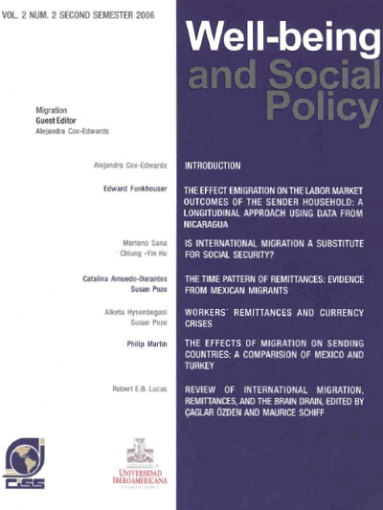
|
|
|
|

|
|
Is international migration a substitute for social security
The focus on short-term macroeconomic factors, including unemployment and wages, is insufficient to explain international migration. Institutional factors, bound to change only in the long run, can potentially have a large impact on migration flows. To illustrate this, we analyze Mexico-U.S. migration focusing on social security coverage, an important indicator of job formality. Using...
|
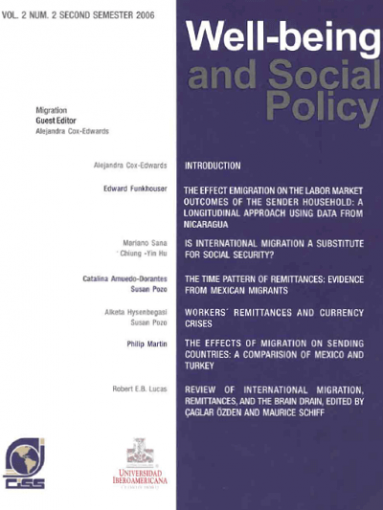
|
|
|
|

|
|
An investigation into the cost of universal health coverage in Mexico
The Mexican social security system, after operating for over six decades, has managed to provide healthcare for slightly over half the resident population.
There are wide geographical and socioeconomic variations in coverage. To provide wider coverage, the Federal Government created the Sistema de Protección Social en Salud (SPSS) for covering low income family. It becomes the third...
|

|
|
|
|

|
|
Introduction (On the studies presented at the International Conference on "Delinquency and Violence in Latin America and the Caribbean")
Crime has become the leading concern for citizens of the region and has been pushed to the forefront of the international policy agenda; what is more, the combination of very few success stories and abundant failures in curbing crime and violence has underscored how thin our understanding is and the difficulty of designing and implementing an effective strategy at the local level. This issue...
|

|
|
|
|

|
|
Crime and labor market, choice under uncertainty model and an application for colombian cities
Este trabajo ofrece un modelo para determinar la función de oferta del crimen con base en la teoría de la elección en condiciones de incertidumbre. Con base en el problema de un agente que maximiza su utilidad sujeto a las restricciones del mercado legal e ilegal, este estudio intenta explicar la oferta de la delincuencia como función de la distribución de los salarios y el equivalente cierto de...
|
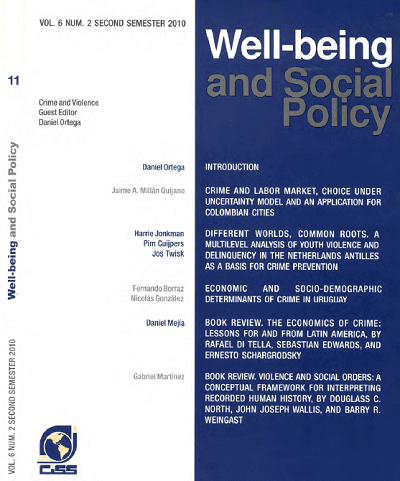
|
|
|
|

|
|
Economic and socio-demographic determinants of crime in Uruguay
This study estimates a panel data model to analyze the economic and socio-demographic determinants of crime in Uruguay across the 19 Uruguayan departments in the period 1986-2006.
This research has two components: i) to present a systematic analysis of the Uruguayan crime data and socio-economic and demographic characteristics of the population, and ii) to evaluate the empirical significance...
|
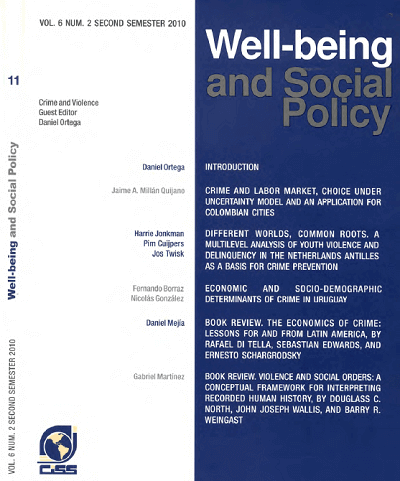
|
|
|
|

|
|
Promised and actual benefits in mexican social security fot rhe transtion generation
Este artículo presenta un conjunto de mediciones de los costos y beneficios reales del plan general de retiro por jubilación proporcionado a los ciudadanos por parte del Sistema Mexicano de Pensiones (SMP), que son necesarias para evaluar las decisiones de los trabajadores en cuanto a la contribución a la seguridad social (es decir, trabajar en el sector formal) y al retiro. El SMP ofrece dos...
|

|
|
|
|

|
|
Book review. The economics of crime: lessons for and from Latina America, by Rafael Di Tella, Sebastian Edwards, and Ernesto Schargrodsky
The Economics of Crime: Lessons for and from Latin America makes an important contribution to the study of crime and violence in Latin America and to the debate about what works for reducing crime (and at what cost?). As the title of the book correctly suggests, the book brings together contributions from Latin American economists on the determinants and consequences of crime, as well as...
|
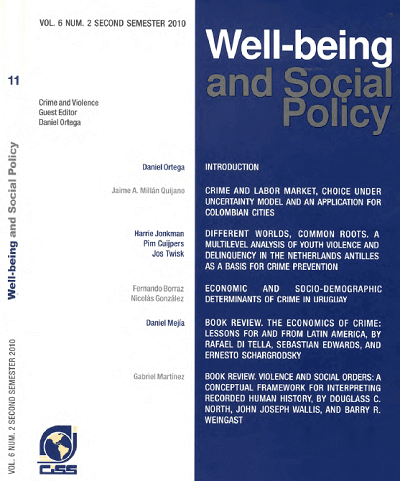
|
|
|
|

|
|
Book review. Violence and social orders: a conceptual framework for interpreting recorded human history, by Douglas C. North, John Joseph Wallis, and Barry R. Weingast
Why societies differ in their level of violence? This is the question addressed by North, Wallis, and Weingast. To provide an answer they must develop a rich theory of how individuals and organizations that compose a human group voluntarily surrender their will to act violently in exchange for participating in a society with improved conditions for the creation and conservation of wealth.
|
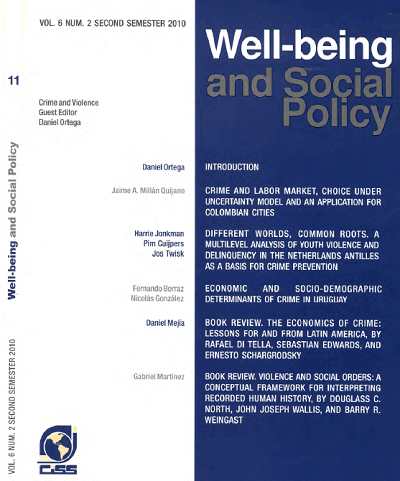
|
|
|
|

|
|
The health insurance reform in the Netherlands and its relevance for Mexico
Alrededor del mundo se observan dos versiones de la organización de los seguros de salud; la seguridad social basada en el empleo, y los servicios nacionales de salud. En Latinoamérica regularmente se usa la primera, pero se está lejos de lograr la cobertura universal. En los Países Bajos encontramos una peculiar mezcla de obligaciones públicas y responsabilidades privadas. La cobertura universal...
|

|
|
|
|

|
|
Feasibility analysis of an integrated health system: financial and distributive implications
The document presents spending projections and projections of the distributive incidence for an Integrated Health System under three basic scenarios: status quo, a two pillar scheme (financed through general taxes and private spending) and a three pillar scheme (financed through general taxes, social security contributions and private spending). By presenting these simulations, the study enhances...
|
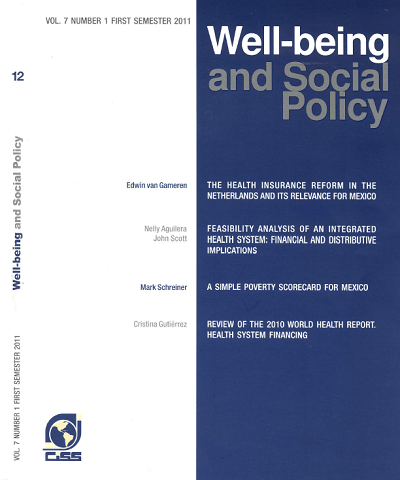
|
|
|
|

|
|
A simple poverty scorecard for Mexico
This study uses Mexico's 2008 National Household Survey of Income and Expenditure to I construct an easy-to-use scorecard that estimates the likelihood that a household has income below a given poverty line. The scorecard uses ten simple indicators that field workers can quickly collect and verify. Poverty scores can be computed on paper in the field in about five to ten minutes. The scorecard's...
|
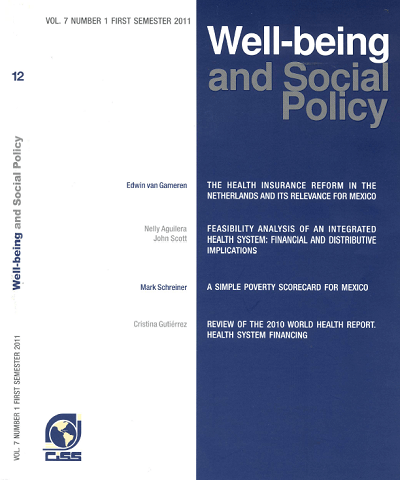
|
|
|
|

|
|
Review of the 2010 World Health Report. Health system financing
The document that was presented by the World Health Organization (WHO) in February 2011 sets forth a series of proposals to encourage member countries to achieve universal health coverage. These proposals are presented in detail and are based both on world statistics and case
studies.
|
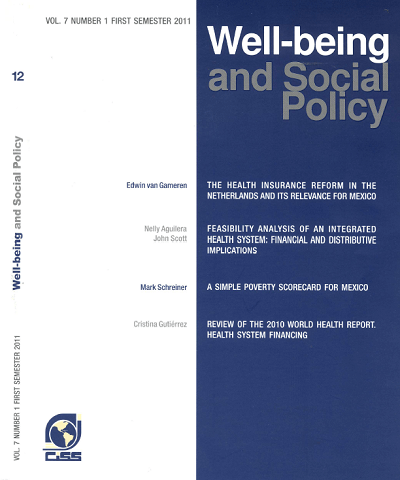
|
|
|
|

|
|
Public spaces in Mexico as social cohesion promoters: an structural modeling perspective
This research assessed the effects of several contextual factors (e.g, neighborhood insecurity, evaluation of public spaces, infrastructure, low risk behaviors) on social cohesion and residential satisfaction, in the context of low and medium-low socio economic status of individuals nearby renovated public spaces (parks and recreational facilities) in Mexico. The research method is based on...
|

|
|
|
|
|